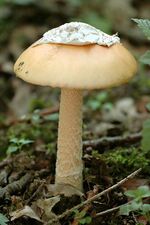Biology:Amanita hygroscopica
| Amanita hygroscopica | |
|---|---|
| Scientific classification | |
| Domain: | Eukaryota |
| Kingdom: | Fungi |
| Division: | Basidiomycota |
| Class: | Agaricomycetes |
| Order: | Agaricales |
| Family: | Amanitaceae |
| Genus: | Amanita |
| Species: | A. hygroscopica
|
| Binomial name | |
| Amanita hygroscopica Coker
| |
| Amanita hygroscopica | |
|---|---|
| Mycological characteristics | |
| gills on hymenium | |
| cap is convex or flat | |
| hymenium is free | |
| stipe has a ring and volva | |
| spore print is white | |
| ecology is mycorrhizal | |
| edibility: deadly | |
Amanita hygroscopia (/æməˈnaɪtə /ha͡ɪɡɹəskˈo͡ʊpi͡ə), also known as the pink-gilled destroying angel is a deadly poisonous fungus, one of many in the genus Amanita.
Taxonomy
The species was first described by William Chambers Coker in 1917.[1]
Description
The cap is 2.5 centimetres (1 inch) wide and hemispheric. The gills are adnate, crowded, medium broad, entire, white, unchanging.
The stem is about 30 by 5–8 millimetres (1 1⁄8 in × 1⁄4 in–3⁄8 in), narrowing upward, smooth, glabrous, white, unchanging when bruised. The ring is fixed 10 mm (3⁄8 in) from the top of the stem, very short, skirt-like, grooved by the gills above, white, persistent. The bulb is ovoid, white, 20 mm × 15 mm (3⁄4 in × 5⁄8 in). The volva is neither appressed nor widely spreading, the edge is either 3-lobed or ragged.[2] The mushroom is odorless and tasteless.
Similar species
A. hygroscopia resembles several edible species, most notably Agaricus campestris.
Toxicity
The principal toxic constituent is α-Amanitin, an elective inhibitor of RNA polymerase II and III, which causes liver and kidney failure. 15% of those poisoned will die within 10 days and those who survive are at risk of lifelong, permanent liver damage.[3]
There is no antidote for amanitin poisoning; treatment is mainly supportive (gastric lavage, activated carbon, and fluid resuscitation).
Amatoxins, the class of toxins found in these mushrooms, are thermostable: they resist changes due to heat, so their toxic effects are not reduced by cooking.
See also
- List of Amanita species
- List of deadly fungi
References
- ↑ "Amanita hygroscopia". Species 2000: Naturalis, Leiden, the Netherlands. https://www.catalogueoflife.org/data/taxon/65ZGW.
- ↑ "Amanita elliptosperma G.F. Atk., A. gwyniana Coker, A. hygroscopica Coker, A. parviformis (Murrill) Murrill, A. pseudoverna (Murrill) Murrill, A. verniformis (Murrill) Murrill". 2011-07-14. http://www.njcc.com/~ret/amanita/species/elliptos.html#hygroscopica.
- ↑ Benjamin, Denis R. (1995). "Amatoxin syndrome". Mushrooms: Poisons and Panaceas – A Handbook for Naturalists, Mycologists and Physicians. New York: W. H. Freeman and Company. pp. 198–214. https://archive.org/details/mushroomspoisons0000benj/page/198/mode/2up.
Wikidata ☰ Q107480887 entry
 |


